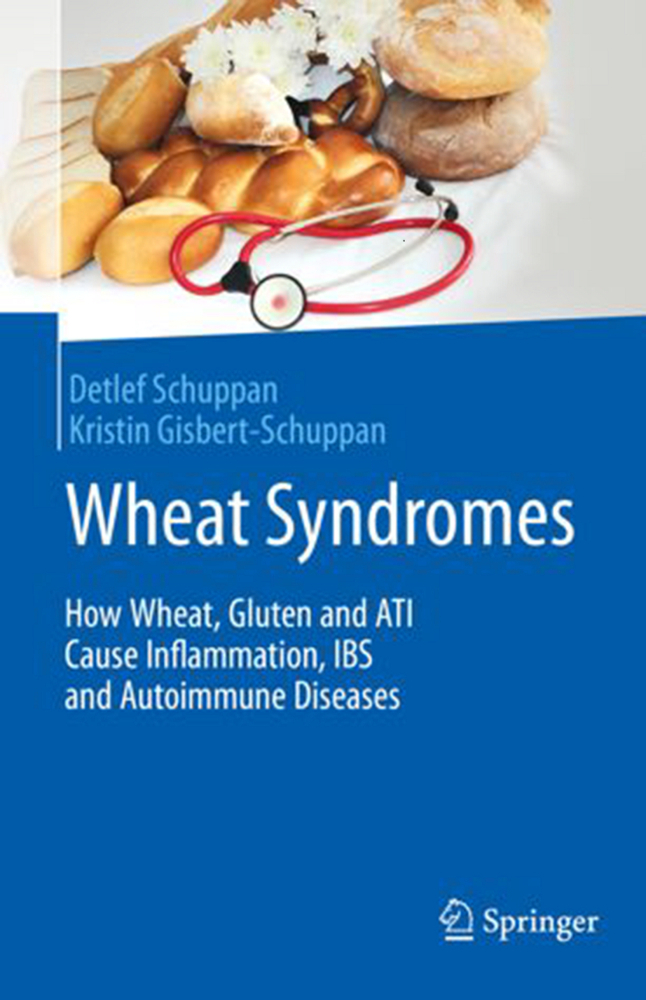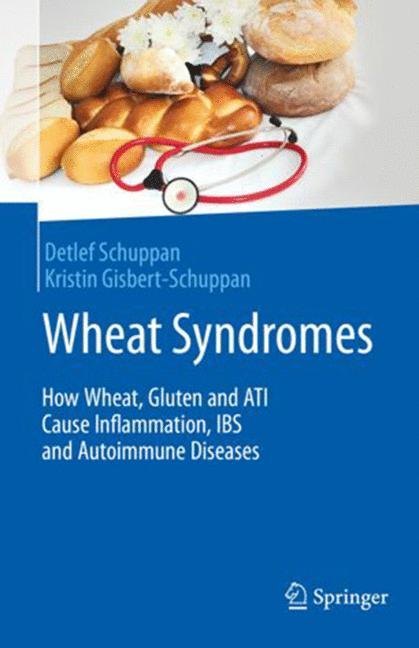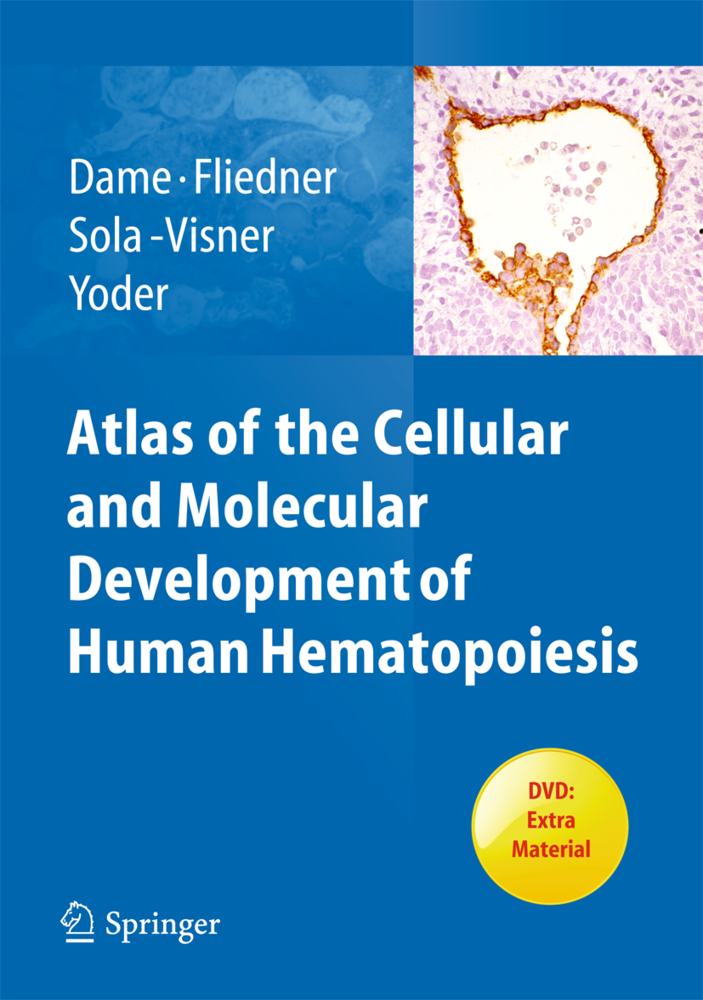Wheat Syndromes
Wheat Syndromes
This book is about three inflammatory conditions that underlie wheat sensitivities caused by the consumption of wheat and related cereals. The book describes, discusses and differentiates celiac disease, amylase trypsin inhibitor (ATI) sensitivity, and the wide spectrum of wheat allergies, especially a novel, but highly common atypical wheat allergy.
The mechanisms of the three wheat sensitivities along with their clinical characteristics, and their their state-of-the art diagnosis and therapy are thoroughly described. This is accompanied by commented case reports. The book is well structured and illustrated with numerous easy-to-grasp yet scientifically updated sketches. The novelty, immunological insight and praxis relevance for specialists as well as patients and interested laypeople makes this book appealing to a broad readership.
Written by an internationally distinguished scientist and clinician in food and wheat related diseases, this book is intended for GPs, internists, gastroenterologists, rheumatologists and immunologists, as well as dieticians, researchers and especially patients who might be affected by these sensitivities.
<p><b> </b></p><p>Foreword</p><p>Acknowledgements by Detlef Schuppan</p><p>Content</p><p>The authors</p><p>1 Introduction</p><p>2 Wheat, gluten and ATI: An overview</p><p>2.1 A brief history of wheat</p><p>2.2 What is gluten?</p><p>2.3 What are ATI?</p><p>3 Immunology of the intestine</p><p>3.1 Our largest immune organ: The intestine</p><p>3.2 Anatomy of an all-rounder</p><p>3.3 An organ in the organ: The intestinal microbiome</p><p>3.4 Immune cells in the intestine</p>3.5 Complexity of the immune system<p></p><p>3.6 Two arms of the immune system: Key to intestinal health</p><p>3.6.1 How does the T cell know when to expand?</p><p>3.6.2 How does the immune system develop tolerance to food?</p><p>3.6.3 What is the "Leaky Gut"?</p><p>4 Celiac disease and its manifold manifestations</p><p>4.1 What is celiac disease?</p><p>4.1.1 Inflammation of the intestine</p><p>4.1.2 Epidemiology of celiac disease</p><p>4.1.3 History and milestones of celiac disease research</p><p>4.1.4 Immunology of celiac disease</p><p>4.1.5 Manifestations of celiac disease</p><p>4.1.6 How to detect celiac disease?</p>4.1.7 Treatment of celiac disease<p></p><p>4.1.8 Summary</p><p>4.2 Case vignettes: Celica disease</p><p>4.2.1 Patient Thomas H. (48 years): Celiac disease after food poisoning</p><p>4.2.2 Patient Martha-Ann (2 years): Failure to thrive</p><p>4.2.3 Patient Stephany G. (34 years): Infertility</p><p>4.2.4 Patient Gregory M. (62 years): Refractory celiac disease</p><p>4.2.5 Patient Paula K. (22 years): Celiac disease combined with an autoimmune disease. </p><p>4.2.6 Summary of the celiac cases</p><p>5 ATI sensitivity</p><p>5.1 Wheat sensitivity: What is it exactly?</p><p>5.1.1 Differential diagnoses of the wheat sensitivities</p>5.2 ATI stimulate the innate immune system<p></p><p>5.3 ATI: An unexpected cause with great effect</p><p>5.3.1 Cells of the innate immune system leave the gut to promote T cell activation</p><p>5.4 The gut as key regulator of immune balance</p><p>5.5 "Gluten-free" is largely "ATI-free"</p><p>5.6 Most of "gluten sensitivity" is ATI-sensitivity</p><p>5.7 ATI: A new paradigm in immunology</p><p>5.7.1 Discovery of tissue transglutaminase as autoantigen of celiac disease</p><p>5.7.2 Discovery of ATI as immune stimulators: another paradigm shift</p><p>5.7.3 ATI promote obesity and associated diseases</p><p>5.7.4 Modern eating habits and the obesity epidemic</p><p>5.7.5 Complex foods</p>5.7.6 Glucose and insulin<p></p><p>5.7.7 Inflammatory body fat: The adipose tissue organ</p><p>5.7.8 Role of ATI in obesity and metabolic syndrome</p><p>5.7.9 Consensus meetings on non-celiac wheat sensitivity</p><p>5.7.10 Are FODMAPs of central relevance? - The answer is no!</p><p>5.8 Case vignettes: Patients with ATI sensitivity</p><p>5.8.1 Patient Carol S. (40 years): Diffuse general complaints</p><p>5.8.2 Patient Ester W. (36 years): Crohn's disease since adolescence</p><p>5.8.3 Patient Michael B. (54 years): Multiple sclerosis</p><p>5.8.4 Patient Bruce K. (49 years): Weight gain and incipient type 2 diabetes</p><p>5.8.5 Patient Kathy S. (40 years): Food allergies</p>5.8.6 Patient Laura K. (23 years): Persistent skin eczema<p></p><p>5.8.7 Patient William P. (63 years): Rheumatoid arthritis</p><p>5.8.8 Summary of the cases with ATI-sensitivity</p><p>6 Lactose, fructose and histamine intolerance: Over-diagnosed and overrated</p><p>6.1 Lactose intolerance</p><p>6.2 Fructose intolerance</p><p>6.3 Histamine intolerance</p><p>6.4 Summary</p><p>7 Classical and atypical food allergies</p><p>7.1 Introduction to classical and atypical food allergies</p><p>7.2 Even classical food allergies can be difficult to diagnose</p><p>7.3 Testing for classical food allergy</p><p></p>7.4 Most food allergies remain undetected: Atypical allergies<p></p><p>7.4.1 What are atypical food allergies?</p><p>7.4.2 Diagnosis of atypical food allergy</p><p>7.5 Summary</p><p></p><p>7.6 Case vignettes: Wheat allergies</p><p>7.6.1 Patient Mary B. (26 years): A special case of wheat allergy</p><p>7.6.2 Patient Samuel R. (52 years): Classic allergy and cross-reaction</p><p>7.6.3 Sylvia H. (48 years): From irritable bowel syndrome to atypical food allergy</p><p>7.6.4 Summary of the cases with wheat allergies</p><p>8 It's not always wheat!</p><p>8.1 Case vignettes: Patients with diseases that superficially look like wheat-sensitivity</p>8.1.1 Patient Curt W. (20 years): Incorrect diagnosis of celiac disease in childhood<p></p><p>8.1.2 Patient Nicole R. (47 years): Inborn immune deficiency</p><p>8.1.3 Patient Emily D. (70 years): Severe small intestinal damage due to a medication</p><p>8.1.4 Patient David P. (39 years): Chronic inflammatory bowel disease</p><p>8.1.5 Summary</p><p>9 Outlook</p><p>9.1 Clinical practice</p><p>9.2 Aspects of further research</p><p>Selected key references with comments</p><p> </p>
Schuppan, Detlef
Gisbert-Schuppan, Kristin
| ISBN | 978-3-030-19022-4 |
|---|---|
| Artikelnummer | 9783030190224 |
| Medientyp | Buch |
| Auflage | 1st ed. 2019 |
| Copyrightjahr | 2019 |
| Verlag | Springer, Berlin |
| Umfang | XV, 142 Seiten |
| Abbildungen | XV, 142 p. 37 illus., 36 illus. in color. |
| Sprache | Englisch |








